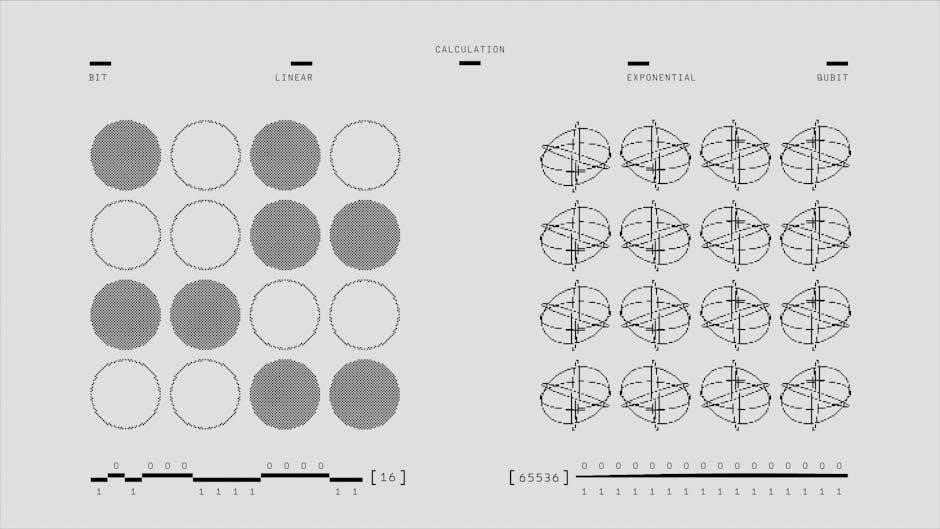The ZF 6HP19 and ZF6HP21 Generation 2 transmissions are advanced 6-speed automatic units designed for high performance and reliability in various vehicle applications.
These transmissions feature improved solenoid systems‚ enhanced pressure control‚ and upgraded internal components compared to their Generation 1 counterparts‚ ensuring smoother shifting and better fuel efficiency.
The solenoid diagram PDF is essential for understanding and repairing these transmissions‚ providing detailed insights into solenoid functionality‚ wiring‚ and pressure regulation systems.
This introduction outlines the key features‚ improvements‚ and operational principles of the ZF 6HP19 and ZF6HP21 Generation 2 transmissions‚ focusing on their solenoid systems and diagnostic capabilities.
1.1 Overview of ZF 6-Speed Automatic Transmissions
ZF 6-speed automatic transmissions‚ including the 6HP19 and 6HP21 models‚ are renowned for their high performance‚ efficiency‚ and reliability in various vehicle applications.
These transmissions utilize advanced solenoid systems to control gear shifts‚ pressure regulation‚ and torque transfer‚ ensuring smooth and responsive driving experiences.
Designed with a focus on fuel efficiency and durability‚ the 6HP19 and 6HP21 transmissions are widely used in both Generation 1 and Generation 2 configurations‚ with the latter offering enhanced solenoid designs and improved pressure control systems.
The solenoid diagram PDF provides critical insights into the electrical and hydraulic components‚ enabling technicians to diagnose and repair issues effectively.
Understanding these transmissions requires a deep dive into their solenoid functionality‚ wiring configurations‚ and pressure regulation mechanisms‚ all of which are meticulously detailed in the solenoid diagram.
By leveraging this information‚ professionals can ensure optimal performance and longevity of the ZF 6-speed automatic transmissions in modern vehicles.
1.2 Key Differences Between Generation 1 and Generation 2
Generation 1 (6HP19/26/32) and Generation 2 (6HP21/28/34) ZF transmissions differ significantly in design and functionality‚ particularly in solenoid systems and pressure control.
Generation 2 units feature upgraded solenoid designs with improved pressure regulation and faster activation cycles‚ enhancing shift quality and overall transmission performance.
The solenoid diagram PDF highlights these advancements‚ showing enhanced wiring configurations and pressure regulator valve interactions in Generation 2 models.
Additionally‚ Generation 2 transmissions incorporate better sealing technologies‚ such as updated O-ring sizes and materials‚ to reduce fluid leaks and improve durability.
These improvements address common issues in Generation 1 models‚ such as inconsistent shift quality and solenoid-related faults‚ making Generation 2 transmissions more reliable and efficient.
The solenoid diagram serves as a crucial tool for understanding these differences and facilitating accurate repairs and maintenance across both generations.

Understanding the Solenoid Diagram PDF
The solenoid diagram PDF provides detailed schematics and insights into the electrical and hydraulic systems of ZF 6HP19 and ZF6HP21 transmissions‚ aiding technicians in repairs and diagnostics.
2.1 Importance of Solenoid Diagrams for Transmission Repair
Solenoid diagrams are critical for diagnosing and repairing issues in ZF 6HP19 and ZF6HP21 Generation 2 transmissions. They provide a visual representation of the solenoid system‚ including wiring‚ connections‚ and pressure control mechanisms.
These diagrams enable technicians to identify faulty solenoids‚ trace electrical circuits‚ and understand how solenoids interact with the transmission’s hydraulic system. Without a solenoid diagram‚ pinpointing issues like inconsistent shifts or pressure regulation problems becomes challenging.
The diagrams also highlight the differences between Generation 1 and Generation 2 solenoid systems‚ such as upgraded solenoid designs and enhanced pressure control in the newer models. This information is essential for accurate repairs and ensures compatibility with the correct components.
By referencing the solenoid diagram‚ technicians can efficiently troubleshoot and replace faulty solenoids‚ ensuring optimal transmission performance and longevity. It serves as an indispensable tool for both novice and experienced professionals working on these advanced transmissions.
2.2 How to Interpret the Solenoid Diagram
Interpreting the solenoid diagram for ZF 6HP19 and ZF6HP21 Generation 2 transmissions requires understanding the layout and symbols used. The diagram typically illustrates the location of each solenoid‚ their wiring connections‚ and how they interact with the transmission’s hydraulic system.
Start by identifying the solenoids labeled in the diagram‚ noting their positions and corresponding functions‚ such as pressure regulation or gear actuation. Color-coding often differentiates between solenoids‚ with each color representing a specific function or circuit.
Next‚ trace the wiring harness connections to ensure proper electrical links between solenoids and the transmission control module. Pay attention to pressure regulator valves and their interaction with solenoids‚ as this affects shift quality and hydraulic pressure.
Finally‚ cross-reference the diagram with the transmission’s technical specifications to confirm compatibility and proper operation. This systematic approach ensures accurate troubleshooting and repair of solenoid-related issues in these advanced transmissions.

Technical Specifications of ZF6HP19 and ZF6HP21
ZF6HP19 and ZF6HP21 transmissions feature advanced 6-speed automatic designs‚ with torque capacities up to 400 Nm and 700 Nm‚ respectively‚ suitable for various vehicle applications.
Generation 2 models include improved solenoid systems‚ enhanced pressure regulation‚ and optimized gear ratios for smoother shifting and increased fuel efficiency compared to earlier versions.
3.1 ZF6HP19 Transmission Specifications
The ZF6HP19 is a 6-speed automatic transmission designed for high performance and reliability‚ with a torque capacity of up to 400 Nm.
It features a compact design‚ making it suitable for a variety of vehicle applications‚ including passenger cars and light-duty trucks.
The transmission incorporates advanced gear ratios and a sophisticated solenoid system for precise control over shifting and pressure regulation.
Key improvements in the ZF6HP19 include enhanced clutch pack configurations and optimized hydraulic controls‚ ensuring smoother and more efficient operation.
The solenoid system in the ZF6HP19 is designed to provide rapid and accurate activation of hydraulic circuits‚ contributing to improved shift quality and reduced wear on internal components.
Serviceable components include the valve body‚ solenoid pack‚ and clutch assemblies‚ making it easier to diagnose and repair common issues using the solenoid diagram PDF.
Overall‚ the ZF6HP19 offers a balance of performance‚ durability‚ and maintainability‚ making it a popular choice for many vehicle manufacturers.
3.2 ZF6HP21 Transmission Specifications
The ZF6HP21 is a Generation 2‚ 6-speed automatic transmission designed for improved performance and efficiency compared to its predecessor‚ the ZF6HP19.
With a higher torque capacity of up to 600 Nm‚ it is suitable for a wider range of applications‚ including heavier vehicles and those requiring increased power delivery.
The ZF6HP21 features an upgraded solenoid system‚ enhanced clutch packs‚ and improved hydraulic controls‚ ensuring faster and smoother gear shifts.
The transmission’s compact design and lightweight construction contribute to better fuel efficiency and reduced emissions‚ making it an ideal choice for modern vehicles.
The solenoid system in the ZF6HP21 is more advanced‚ providing better pressure regulation and more precise control over hydraulic circuits‚ which is detailed in the solenoid diagram PDF.
Serviceability is enhanced with easier access to components like the valve body and solenoid pack‚ allowing for quicker diagnostics and repairs using the provided specifications.
Overall‚ the ZF6HP21 represents a significant advancement in automatic transmission technology‚ offering improved performance‚ efficiency‚ and reliability.
3.3 Generation 2 Improvements Over Generation 1
Generation 2 transmissions‚ including the ZF6HP21‚ offer several enhancements over their Generation 1 counterparts‚ such as the ZF6HP19.
Key improvements include upgraded solenoid designs‚ enhanced pressure control systems‚ and better hydraulic efficiency‚ leading to smoother and more precise gear shifts.
The Generation 2 units feature improved torque handling capabilities‚ with a higher maximum torque capacity of up to 600 Nm‚ making them suitable for heavier and more powerful applications.
Additionally‚ the second-generation transmissions incorporate advanced clutch pack configurations and refined valve body designs‚ which reduce wear and tear and improve overall durability.
The solenoid systems in Generation 2 are more robust‚ with better thermal management and reduced susceptibility to electrical faults‚ as detailed in the solenoid diagram PDF.
These enhancements collectively contribute to improved fuel efficiency‚ reduced emissions‚ and enhanced driver comfort compared to the earlier Generation 1 models.

Solenoid Functionality in ZF6HP19 and ZF6HP21
Solenoids in ZF6HP19 and ZF6HP21 regulate hydraulic pressure‚ enabling precise control over gear shifts‚ torque transfer‚ and clutch engagement‚ ensuring smooth and efficient transmission operation.
4.1 Role of Solenoids in Automatic Transmissions
Solenoids are critical components in automatic transmissions‚ controlling the flow of hydraulic fluid to engage or disengage clutches and bands‚ enabling smooth gear shifts.
They regulate pressure applied to the clutch packs and planetary gear sets‚ ensuring proper torque transfer and ratio changes during acceleration or deceleration.
In ZF6HP19 and ZF6HP21 transmissions‚ solenoids are electrically controlled‚ allowing precise modulation of hydraulic pressure based on engine speed‚ load‚ and driver input;
Their operation is synchronized with the transmission control module (TCM)‚ which processes data to optimize shift timing and performance;
Solenoids also interact with the pressure regulator valve and wire harness configurations‚ ensuring accurate signal transmission and consistent transmission behavior.
Their proper functioning is essential for maintaining transmission reliability‚ fuel efficiency‚ and overall vehicle performance‚ making them a focal point in diagnostics and repairs;
4.2 Solenoid Activation and Deactivation Cycles
Solenoid activation and deactivation cycles in ZF6HP19 and ZF6HP21 Generation 2 transmissions are precisely controlled by the transmission control module (TCM).
Activation occurs when an electrical signal is sent to the solenoid‚ opening or closing valves to direct hydraulic fluid flow‚ enabling clutch engagement or disengagement.
Deactivation happens when the signal is interrupted‚ allowing the solenoid to return to its default state‚ typically controlled by spring force.
These cycles are synchronized with engine speed‚ throttle position‚ and load to ensure smooth gear transitions and optimal performance.
The solenoid diagram PDF provides a visual representation of these cycles‚ aiding technicians in diagnosing activation and deactivation issues.
Generation 2 transmissions feature enhanced solenoid designs‚ improving the accuracy and speed of these cycles compared to earlier models.
Proper functioning of these cycles is vital for maintaining transmission reliability and performance‚ making them a key focus in repair and maintenance procedures.

Solenoid Diagram Components
The solenoid diagram includes solenoid locations‚ wire harness configurations‚ and pressure regulator valve interactions‚ essential for understanding hydraulic control in ZF6HP19 and ZF6HP21 Generation 2 transmissions.
5.1 Identifying Solenoid Locations and Connections
The solenoid diagram PDF provides a detailed layout of solenoid locations within the ZF6HP19 and ZF6HP21 Generation 2 transmissions‚ ensuring accurate identification and connection mapping.
Each solenoid is labeled with its specific function‚ such as the pressure regulator valve solenoid or clutch pack solenoids‚ helping technicians pinpoint their exact positions in the valve body.
The diagram also illustrates wire harness configurations‚ showing how each solenoid connects to the transmission control module (TCM) and other electrical components.
By referencing the PDF‚ technicians can quickly identify faulty solenoids‚ trace wiring issues‚ and perform precise repairs‚ ensuring proper hydraulic pressure control and smooth transmission operation.
Understanding these connections is critical for diagnosing issues like soft shifts or erratic gear changes‚ often linked to solenoid malfunctions or wiring faults.
The Generation 2 transmissions feature upgraded solenoid designs‚ which are clearly highlighted in the diagram‚ aiding in the identification of improved components compared to earlier models.
Additionally‚ the PDF includes notes on O-ring sizes and sealing locations‚ essential for maintaining hydraulic integrity during solenoid replacements or valve body overhauls.
5.2 Understanding Solenoid Wire Harness Configurations
The solenoid wire harness configurations in ZF6HP19 and ZF6HP21 Generation 2 transmissions are detailed in the PDF diagram‚ showcasing the electrical connections and wiring layouts.
Each solenoid is connected to the transmission control module (TCM) through a specific wire harness‚ ensuring precise electronic control over hydraulic pressure and clutch engagement.
The diagram highlights color-coded wires‚ pin assignments‚ and connector locations‚ aiding technicians in tracing circuits and diagnosing electrical faults.
Generation 2 transmissions feature enhanced wiring configurations‚ including updated connectors and improved shielding‚ reducing susceptibility to electromagnetic interference.
Understanding these configurations is vital for troubleshooting issues like intermittent solenoid activation or communication errors between the TCM and solenoids.
The PDF also provides schematics for both M-shift and E-shift valve bodies‚ ensuring compatibility with various transmission control strategies;
Proper harness routing and connection integrity are emphasized to prevent damage and ensure reliable operation of the solenoid system.
These details are essential for accurate repairs and maintaining optimal transmission performance.
5.3 Pressure Regulator Valve and Solenoid Interaction
The pressure regulator valve (PRV) in ZF6HP19 and ZF6HP21 Generation 2 transmissions works in tandem with solenoids to regulate hydraulic pressure precisely.
Solenoids control the flow of hydraulic fluid to the PRV‚ enabling dynamic pressure adjustments based on driving conditions and TCM signals.
The PRV ensures consistent line pressure‚ which is critical for smooth gear shifts and clutch engagement.
In Generation 2 models‚ solenoids interact with the PRV through enhanced pressure control systems‚ offering improved responsiveness and accuracy.
The solenoid diagram PDF illustrates how these components communicate‚ detailing hydraulic flow paths and electrical signals.
Technicians can use the diagram to diagnose issues like inconsistent pressure or faulty solenoid activation‚ ensuring proper PRV function.
This interaction is vital for maintaining optimal transmission performance and preventing premature wear.
Understanding this relationship is key to effective troubleshooting and repair of solenoid-related issues in these transmissions.
The PDF provides a clear visual guide to ensure accurate identification of components and their interactions.

Proper alignment and functionality of the PRV and solenoids are essential for reliable operation.

Generation 2 Solenoid Diagram Specifics
- Generation 2 solenoid diagrams reveal enhanced pressure control systems and upgraded solenoid designs.
- Improved solenoid activation cycles ensure precise hydraulic pressure regulation.
- The PDF highlights advanced diagnostic features for troubleshooting.
- Upgraded solenoid interactions with the pressure regulator valve are detailed.
- These enhancements improve transmission performance and repair accuracy.
6.1 Upgraded Solenoid Designs in Generation 2
Generation 2 transmissions feature upgraded solenoid designs that enhance performance and reliability. These improvements include optimized coil winding configurations‚ better heat dissipation‚ and more durable materials.
The solenoids in the ZF6HP21 Generation 2 are designed to handle higher pressure demands and provide more precise control over hydraulic flow‚ reducing wear on internal components.
The solenoid diagram PDF highlights these changes‚ showing how the redesigned solenoids integrate with the pressure regulator valve for smoother shifting and improved fuel efficiency.
These upgrades address common issues from Generation 1‚ such as inconsistent shift quality and solenoid failure‚ ensuring longer transmission life and better overall performance.
6.2 Enhanced Solenoid Pressure Control Systems
Generation 2 transmissions boast enhanced solenoid pressure control systems‚ providing precise hydraulic pressure management for improved shifting and fuel efficiency.
The upgraded solenoid designs work in tandem with the pressure regulator valve to maintain optimal pressure levels across all gear ranges‚ reducing wear on internal components.
These advancements ensure smoother transitions between gears and better torque handling‚ particularly under varying load conditions.
The solenoid diagram PDF illustrates these improvements‚ detailing how the pressure control systems integrate with the solenoid activation cycles for enhanced performance.
Overall‚ the Generation 2 pressure control systems represent a significant leap forward in transmission technology‚ offering drivers a more responsive and reliable driving experience.

Troubleshooting Solenoid-Related Issues
Common solenoid faults in ZF6HP19 and ZF6HP21 include soft shifts‚ poor line pressure‚ and erratic gear changes. The solenoid diagram PDF aids in diagnosing these issues by tracing electrical circuits and identifying faulty solenoids or wiring connections. Technicians can test solenoid activation cycles and pressure regulation to pinpoint malfunctions. Regular inspection of solenoid alignment and wiring integrity is crucial for maintaining optimal transmission performance and preventing costly repairs;
7.1 Common Solenoid Faults in ZF6HP19 and ZF6HP21
Common solenoid faults in ZF6HP19 and ZF6HP21 transmissions include soft or erratic shifts‚ poor line pressure regulation‚ and unexpected gear changes. These issues often stem from faulty solenoid activation‚ wiring harness problems‚ or pressure regulator malfunctions. Stuck or worn solenoids can disrupt hydraulic pressure control‚ leading to slipping or hesitation during acceleration. Additionally‚ improper solenoid alignment or damaged connectors may cause intermittent electrical signals‚ further complicating transmission operation. The solenoid diagram PDF is instrumental in identifying these faults by providing a clear visual representation of solenoid locations‚ connections‚ and activation sequences. By referencing the diagram‚ technicians can trace circuits‚ test solenoid performance‚ and isolate faulty components efficiently‚ ensuring accurate repairs and restoring smooth transmission functionality.
7.2 Diagnostic Techniques Using the Solenoid Diagram
Utilizing the solenoid diagram PDF is crucial for diagnosing issues in ZF6HP19 and ZF6HP21 transmissions. The diagram provides a detailed layout of solenoid locations‚ connections‚ and activation sequences‚ aiding in systematic troubleshooting. Technicians can identify symptoms like soft shifts or erratic gear changes and trace them to specific solenoids. By cross-referencing the diagram with the vehicle’s wiring harness‚ one can detect electrical faults or disconnections. Testing solenoid activation cycles and pressure regulation using the diagram’s guidance ensures accurate diagnosis. Additionally‚ the diagram helps in verifying hydraulic pressure levels against specifications‚ pinpointing issues such as faulty solenoids or pressure regulator malfunctions. This methodical approach enables efficient identification and repair of solenoid-related problems‚ ensuring optimal transmission performance.

Maintenance and Repair Tips
Regular maintenance and proper repair techniques are essential for extending the lifespan of ZF6HP19 and ZF6HP21 transmissions. Always refer to the solenoid diagram PDF for accurate repairs.
8.1 Best Practices for Solenoid Replacement
When replacing solenoids in ZF6HP19 and ZF6HP21 Generation 2 transmissions‚ always refer to the solenoid diagram PDF for accurate wiring and installation guidance.
Use genuine or high-quality aftermarket solenoids to ensure compatibility and performance. Clean the solenoid cavity thoroughly before installation to prevent contamination.
Apply a thin layer of transmission fluid to new O-rings and seals‚ and ensure proper alignment to avoid damage during insertion.
Refer to the PDF for specific torque specifications and electrical connections. Test the transmission after replacement to verify smooth operation and proper solenoid function.
8.2 Importance of Proper Solenoid Alignment
Proper solenoid alignment is critical to ensure optimal performance and longevity of the ZF6HP19 and ZF6HP21 Generation 2 transmissions.
Misalignment can lead to mechanical damage‚ fluid leaks‚ or electrical malfunctions‚ potentially causing costly repairs.
Always refer to the solenoid diagram PDF to verify correct positioning and connections before installation.
Use alignment tools or guides to ensure solenoids are seated correctly‚ avoiding uneven wear or stress on internal components.
Improper alignment can disrupt pressure regulation and shift quality‚ so careful attention is essential during replacement or adjustment.

Tools and Resources Needed
Essential tools include a solenoid testing kit‚ pressure gauge‚ and torque wrench for precise adjustments. The solenoid diagram PDF and repair manuals are crucial for accurate diagnostics and maintenance.
9.1 Essential Tools for Solenoid Repair and Maintenance
Essential tools for solenoid repair include a solenoid testing kit‚ pressure gauge‚ and torque wrench for precise adjustments.
- A multimeter for diagnosing electrical issues in solenoid circuits.
- A hydraulic pressure test kit to verify solenoid-activated pressure levels.
- A set of metric sockets and wrenches for disassembling the transmission.
- Replacement O-rings and seals to ensure proper reassembly.
- The solenoid diagram PDF for accurate wiring and connection references.
These tools enable technicians to perform efficient and accurate solenoid repairs‚ ensuring optimal transmission performance.
9.2 Recommended PDF Resources for ZF6HP19 and ZF6HP21
Several PDF resources are essential for understanding and working with ZF6HP19 and ZF6HP21 Generation 2 transmissions‚ particularly their solenoid systems.
- The ZF6HP21/28/34 (Gen. 2) ZIP Kit provides detailed solenoid repair instructions and diagrams.
- The ZF6HP21 Technicians Diagnostic Guide offers troubleshooting tips and solenoid-related fault codes.
- The Solenoid Pressure Regulator Valve Manual explains how to test and replace solenoids effectively.
- The ZF6HP19/21 Solenoid Diagram PDF includes wiring configurations and activation cycles.
- Technical Service Bulletins (TSBs) from ZF or OEMs address common issues and updates for Generation 2 transmissions.
These resources are available on manufacturer websites‚ forums‚ or repair shops‚ ensuring comprehensive guidance for solenoid repairs and maintenance.
The ZF6HP19 and ZF6HP21 Generation 2 transmissions offer enhanced performance and reliability‚ with solenoid systems playing a crucial role in their operation and efficiency.
10.1 Summary of Key Points
The ZF6HP19 and ZF6HP21 Generation 2 transmissions represent significant advancements in automatic transmission technology‚ with improved solenoid systems and enhanced pressure control.
Key improvements include upgraded solenoid designs‚ better shift quality‚ and increased durability compared to Generation 1 models‚ addressing common issues like inconsistent shifting and pressure regulation.
The solenoid diagram PDF is indispensable for diagnostics and repairs‚ offering detailed insights into solenoid functionality‚ wiring configurations‚ and pressure regulator interactions.
Proper maintenance‚ such as solenoid alignment and replacement‚ is critical for optimal performance and longevity‚ ensuring the transmission operates efficiently under various driving conditions.
By leveraging the solenoid diagram and following best practices‚ technicians can effectively troubleshoot and maintain these advanced transmissions‚ maximizing their reliability and performance over time.
10.2 Final Thoughts on Solenoid Diagram Usage
The solenoid diagram PDF is an invaluable resource for understanding and working with ZF6HP19 and ZF6HP21 Generation 2 transmissions‚ offering detailed insights into their complex systems.
By leveraging this diagram‚ technicians can accurately diagnose and repair issues‚ ensuring optimal performance and longevity of the transmission.
Regular maintenance‚ proper solenoid alignment‚ and adherence to best practices are crucial for maximizing the efficiency and reliability of these advanced transmissions.
For anyone working on these units‚ the solenoid diagram serves as an essential guide‚ simplifying complex procedures and enhancing overall understanding of their operation.

